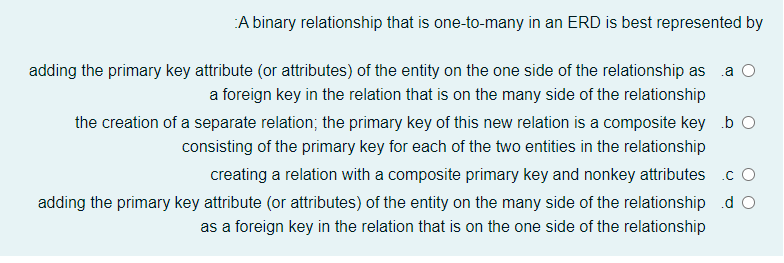A binary relationship that is one-to-many in an ERD is best represented by adding the primary key attribute (or attributes) of the entity on the one side of the relationship as .a O a foreign key in the relation that is on the many side of the relationship the creation of a separate relation; the primary key of this new relation is a composite key b O consisting of the primary key for each of the two entities in the relationship creating a relation with a composite primary key and nonkey attributes .c O adding the primary key attribute (or attributes) of the entity on the many side of the relationship .d O as a foreign key in the relation that is on the one side of the relationship
A binary relationship that is one-to-many in an ERD is best represented by adding the primary key attribute (or attributes) of the entity on the one side of the relationship as .a O a foreign key in the relation that is on the many side of the relationship the creation of a separate relation; the primary key of this new relation is a composite key b O consisting of the primary key for each of the two entities in the relationship creating a relation with a composite primary key and nonkey attributes .c O adding the primary key attribute (or attributes) of the entity on the many side of the relationship .d O as a foreign key in the relation that is on the one side of the relationship
Database System Concepts
7th Edition
ISBN:9780078022159
Author:Abraham Silberschatz Professor, Henry F. Korth, S. Sudarshan
Publisher:Abraham Silberschatz Professor, Henry F. Korth, S. Sudarshan
Chapter1: Introduction
Section: Chapter Questions
Problem 1PE
Related questions
Question
q11

Transcribed Image Text:A binary relationship that is one-to-many in an ERD is best represented by
adding the primary key attribute (or attributes) of the entity on the one side of the relationship as .a O
a foreign key in the relation that is on the many side of the relationship
the creation of a separate relation; the primary key of this new relation is a composite key b O
consisting of the primary key for each of the two entities in the relationship
creating a relation with a composite primary key and nonkey attributes c O
adding the primary key attribute (or attributes) of the entity on the many side of the relationship d O
as a foreign key in the relation that is on the one side of the relationship
Expert Solution
This question has been solved!
Explore an expertly crafted, step-by-step solution for a thorough understanding of key concepts.
Step by step
Solved in 2 steps

Knowledge Booster
Learn more about
Need a deep-dive on the concept behind this application? Look no further. Learn more about this topic, computer-science and related others by exploring similar questions and additional content below.Recommended textbooks for you

Database System Concepts
Computer Science
ISBN:
9780078022159
Author:
Abraham Silberschatz Professor, Henry F. Korth, S. Sudarshan
Publisher:
McGraw-Hill Education

Starting Out with Python (4th Edition)
Computer Science
ISBN:
9780134444321
Author:
Tony Gaddis
Publisher:
PEARSON

Digital Fundamentals (11th Edition)
Computer Science
ISBN:
9780132737968
Author:
Thomas L. Floyd
Publisher:
PEARSON

Database System Concepts
Computer Science
ISBN:
9780078022159
Author:
Abraham Silberschatz Professor, Henry F. Korth, S. Sudarshan
Publisher:
McGraw-Hill Education

Starting Out with Python (4th Edition)
Computer Science
ISBN:
9780134444321
Author:
Tony Gaddis
Publisher:
PEARSON

Digital Fundamentals (11th Edition)
Computer Science
ISBN:
9780132737968
Author:
Thomas L. Floyd
Publisher:
PEARSON

C How to Program (8th Edition)
Computer Science
ISBN:
9780133976892
Author:
Paul J. Deitel, Harvey Deitel
Publisher:
PEARSON

Database Systems: Design, Implementation, & Manag…
Computer Science
ISBN:
9781337627900
Author:
Carlos Coronel, Steven Morris
Publisher:
Cengage Learning

Programmable Logic Controllers
Computer Science
ISBN:
9780073373843
Author:
Frank D. Petruzella
Publisher:
McGraw-Hill Education